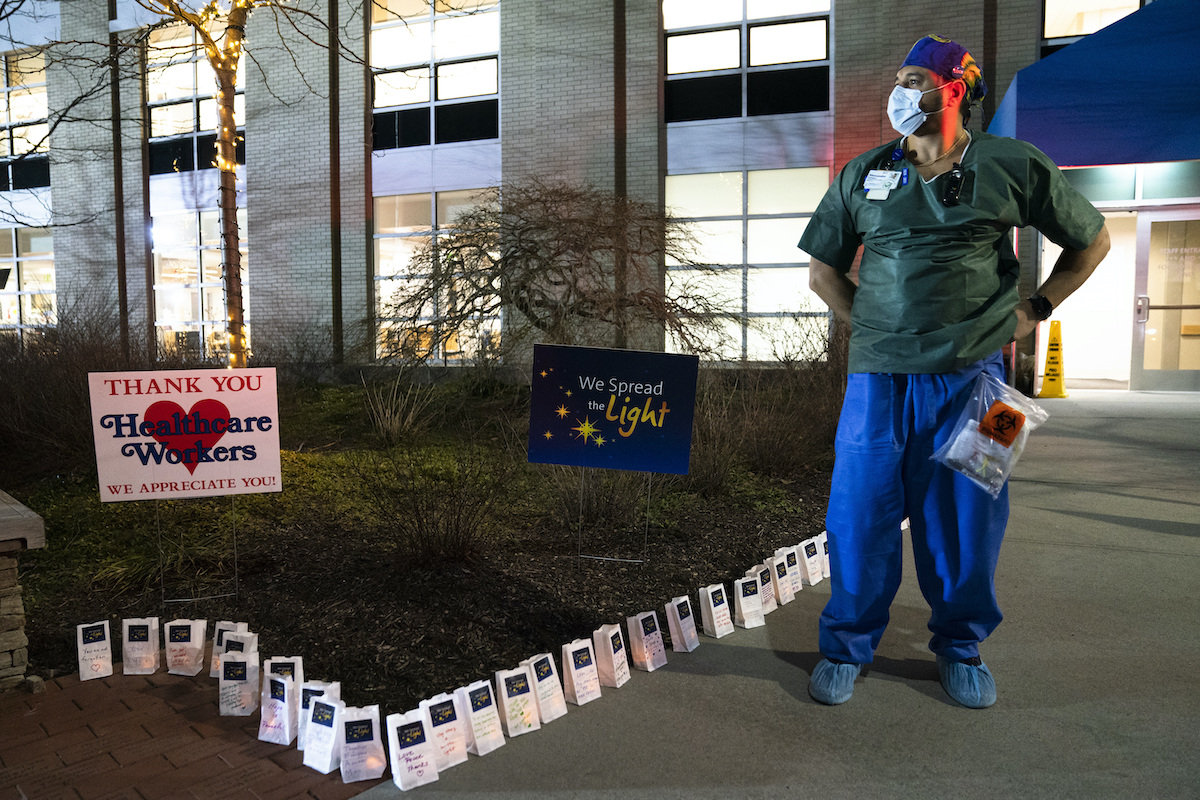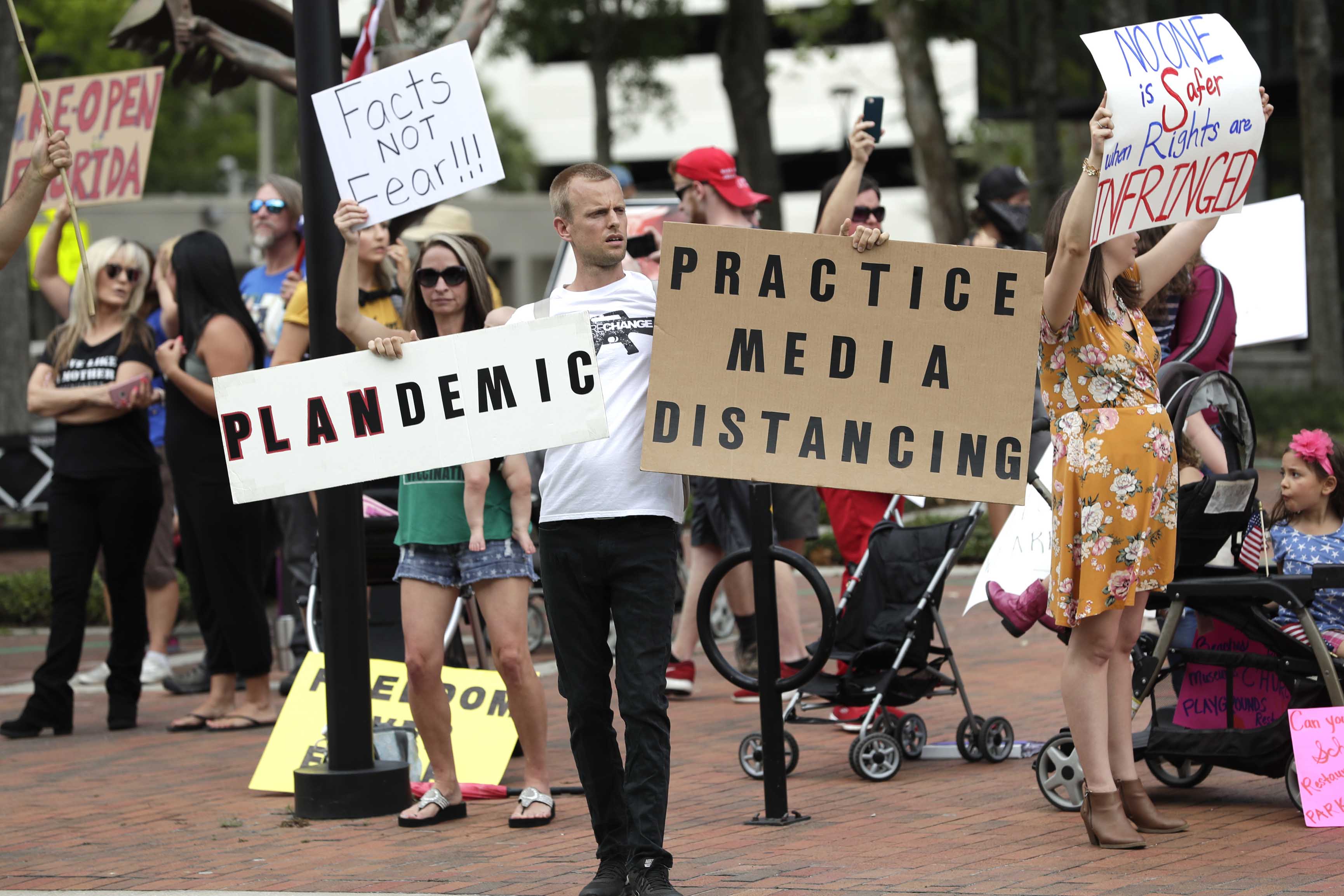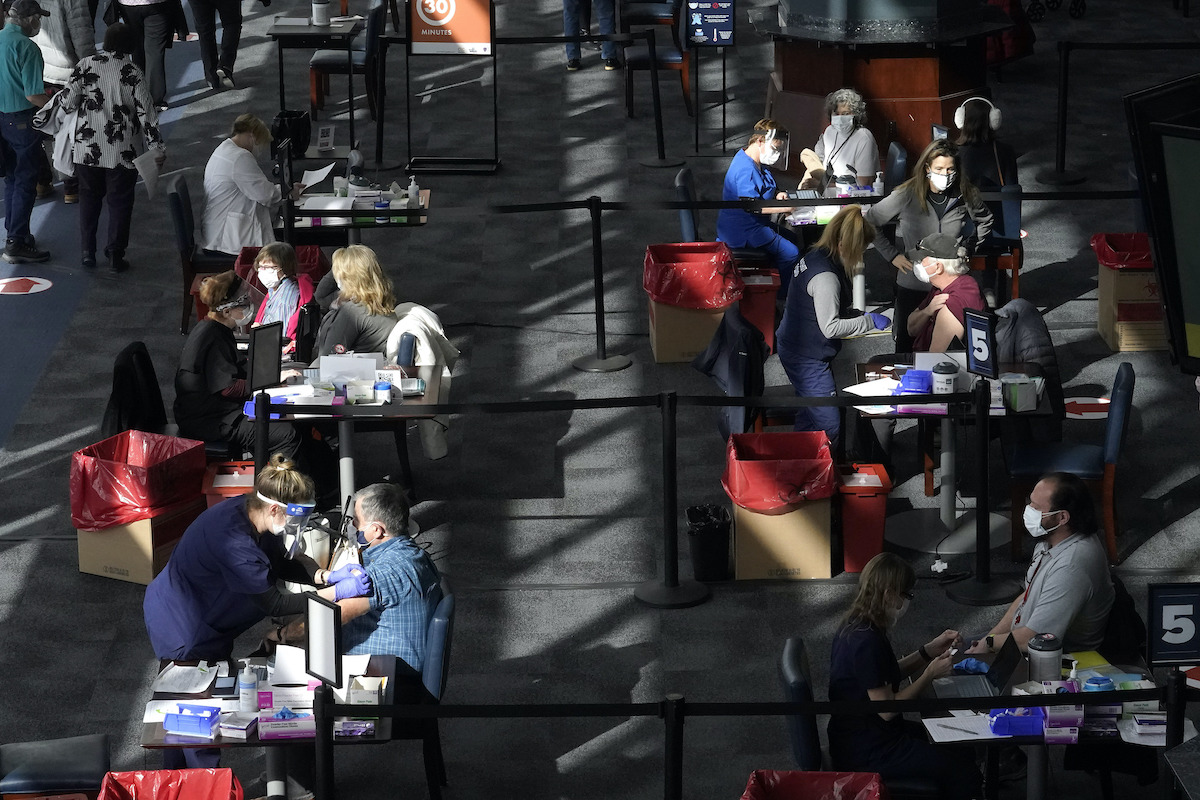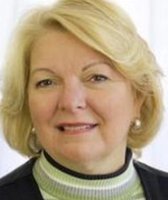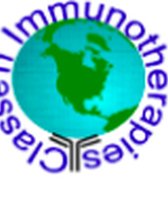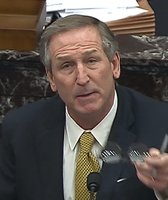Get PolitiFact in your inbox.
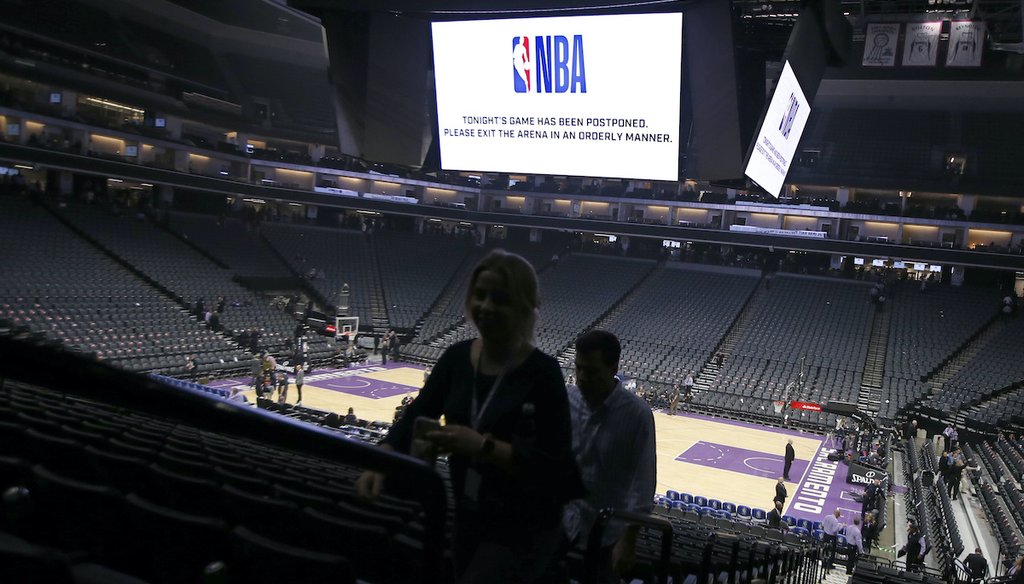
Fans leave the Golden 1 Center after the NBA basketball game between the New Orleans Pelicans and Sacramento Kings was postponed at the last minute in Sacramento, Calif., on March 11, 2020. (AP)
One year ago, Tom Hanks and his wife, Rita Wilson, tested positive for the novel coronavirus. The NBA suspended its season. About 1,000 Americans were infected, and the World Health Organization declared a pandemic.
Today, more than 500,000 Americans are dead from COVID-19. The country is recovering from the worst economic crisis since the Great Depression. Schools and colleges, many shuttered since last spring, are slowly reopening. Playing in the background: a symphony of falsehoods downplaying and denying the severity of the pandemic.
Since the novel coronavirus first emerged in late 2019, PolitiFact has fact-checked nearly 800 claims — 60% of which we rated False or Pants on Fire! In the early days of the pandemic, much of the misinformation focused on ways to cure or prevent COVID-19. Now, disinformation is casting doubt on the efficacy and safety of coronavirus vaccines.
Here are a few things we’ve observed and learned while fact-checking coronavirus claims over the past year — and some lessons for how to avoid misinformation in what we hope is the twilight of the pandemic.
In spring 2020, there was a lot that scientists didn’t know about the coronavirus, including where it came from, how it spread or how to treat it.
Those uncertainties left a gap in public knowledge about the virus and the disease it caused, COVID-19. Misinformation filled that gap.
Facebook users speculated that sunlight could kill the coronavirus (False). Others said drinking water or — better yet — hot lemon water could prevent infection (Both False). Vegan Instagram accounts said there’d be no pandemic if people didn’t eat animals (Mostly False). Health misinformation websites spread conspiracy theories that the virus was created in a lab (False).
Scientists know more about the novel coronavirus in 2021 than they did last year, but there is still no known cure or treatment for COVID-19. So remain skeptical of any claims on social media or elsewhere that seem to lack context about the virus. Remember: Don’t share something on social media unless you know it’s true.
From the earliest days of the pandemic, there was a concerted effort by politicians and commentators to deny or downplay the severity of COVID-19.
Pundits like Rush Limbaugh and David Harris Jr. likened the coronavirus to the common cold (False) and the flu (Pants on Fire). Politicians like Sen. Marco Rubio, R-Fla., and Florida Gov. Ron DeSantis selectively cited data to make the virus seem less deadly than it actually was. On social media, some denied the existence of COVID-19 altogether or posted photos of empty hospital beds to claim the crisis was fake.
A remembrance ceremony is held outside the staff entrance to Northern Westchester Hospital to commemorate the one-year anniversary of the first COVID-19 patient admission on March 11, 2021, in Mount Kisco, N.Y. (AP)
Of course, the crisis was real — weekly hospitalizations and daily deaths shot up between March and April. But claims denying that reality continued to proliferate, particularly after states imposed coronavirus restrictions and face mask mandates. The denialism continued well into the fall, when former President Donald Trump said the country was "rounding the turn" on COVID-19 (False). Within weeks, cases and deaths shot up again.
"When people are fearful, they seek information to reduce uncertainty," said Jeff Hancock, a communication professor at Stanford University, in a March 2020 blog post. "This can lead people to believe information that may be wrong or deceptive because it helps make them feel better, or allows them to place blame about what’s happening."
In May, millions of people saw a video that claimed face masks don’t work, that the coronavirus was manipulated and that the drug hydroxychloroquine was an effective way to treat it. The messenger: a scientist named Judy Mikovits.
The impact of her video, "Plandemic: The Hidden Agenda Behind COVID-19," showed that misinformation about COVID-19 is particularly effective when the source appears to have an air of authority. Mikovits’ claims were wrong, and her work on chronic fatigue syndrome and vaccines has been widely discredited, but the 26-minute "Plandemic" video still reached millions of people on Facebook, Instagram, Twitter and YouTube.
Its slick editing and marketing set the bar for other videos that contained COVID-19 misinformation. In July, Breitbart published a clip that showed doctors in white lab coats outside the U.S. Supreme Court. They discouraged mask wearing and falsely said hydroxychloroquine, a drug used to treat rheumatoid arthritis and lupus, could cure the coronavirus.
Some of the most effective coronavirus misinformation comes from people who appear to know what they’re talking about. Just because someone wears a white lab coat and has a medical degree does not mean their claims about COVID-19 are accurate. Get your facts from public health agencies with good track records like the Centers for Disease Control and Prevention to avoid being duped.
What do anti-vaccine advocates, QAnon supporters and lockdown protesters have in common? In 2020, they all teamed up to spread conspiracy theories about COVID-19.
Microsoft co-founder Bill Gates was a common target, falsely accused of planting microchips in people via vaccines and patenting the coronavirus to profit from its treatment. Supporters of QAnon, a baseless conspiracy theory about child sex trafficking, promoted hydroxychloroquine as a COVID-19 cure and false claims about vaccines. False claims doubting the efficacy of face masks spread widely in alternative health and pro-Trump communities.
Protesters demanding Florida businesses and government reopen, march in downtown Orlando, on April 17, 2020. (AP)
Experts say the coordination between different conspiracy groups, such as left-leaning anti-vaccine communities and right-leaning QAnon supporters, in pushing these false claims was surprising. But given how social media platforms work, it shouldn’t have been.
"These networks are wired to spread disinformation about the virus," said Kate Starbird, an associate professor at the University of Washington, in a December interview. "They’re highly motivated for political reasons to select claims or pieces of evidence to support their narrative — and to seek to downplay its effects or claim that masks or social distancing not work for whatever reason."
When you think of online misinformation, you may think of social media rumors, conspiracy theorists or foreign disinformation campaigns. But in 2020, a lot of coronavirus misinformation came from the White House.
In February 2020, Trump told the country to view the coronavirus "the same as the flu," a line echoed by pundits and Facebook users throughout the year. He promoted hydroxychloroquine as a potential coronavirus treatment, setting the stage for others to claim the drug was a miracle cure. In the weeks leading up to Election Day, Trump falsely claimed the U.S. was padding COVID-19 death numbers.
Sometimes, the president would repeat misinformation he saw online, such as a bogus claim that only 6% of COVID-19 deaths were actually caused by the virus. But Trump himself was the source of much of the coronavirus misinformation we saw over the past year, illustrating how those with the biggest platforms have the biggest potential to misinform.
"Bottom-up misinformation seems inevitable in any circumstance like this," said Brendan Nyhan, a government professor at Dartmouth College, in a December interview, adding: "But it wasn’t inevitable that our elites would downplay the severity of this threat for as long as they have."
False COVID-19 claims are more than just a distraction from the public health crisis — they can directly affect people’s lives and health.
A Florida taxi driver and his wife got sick after believing online conspiracy theories about face masks and 5G data networks; the wife later died from complications related to COVID-19. A lecturer at Columbia University had trouble filling her prescription for a lupus drug after Trump and others touted hydroxychloroquine as a coronavirus cure. Nurses and doctors on the frontline of the pandemic took to social media to dispel rumors, some of which they heard from patients who were sick with COVID-19.
People receive COVID-19 vaccines on Feb. 11, 2021, at a vaccination center at Gillette Stadium in Foxborough, Mass. (AP)
The effect of misinformation can also be seen in polling data from 2020. A NPR/Ipsos poll from December showed that 40% of Americans falsely believed the coronavirus was created in a lab in China. In July, a quarter of Americans thought there was some truth to the conspiracy theory that the pandemic was planned. Throughout the year, about 30% of Americans thought the threat "has been exaggerated" and the virus was "purposely created and released."
It’s not all bad news, though.
Joseph Uscinski, a conspiracy theory expert at the University of Miami, conducted the polling on Americans’ belief in an exaggerated or fabricated virus. He said the percentage of people who held those beliefs stayed relatively stable last year, meaning that the spread of conspiracy theories doesn’t necessarily cause an increase in believers. And as the coronavirus vaccine rollout continues, a February Gallup poll found that 71% of Americans are willing to receive the vaccine — an increase from 50% in the fall.
Katie Sanders contributed to this report.
Our Sources
BBC, "Coronavirus: What we still don't know about Covid-19," March 29, 2020
BBC, "Coronavirus: The human cost of virus misinformation," May 27, 2020
BBC, "What we know and don't know about Covid-19," Feb. 28, 2021
BuzzFeed News, "This Nurse Is Speaking Out Against Coronavirus Rumors And Hoaxes That Are Putting Him And His Colleagues In Danger," April 28, 2020
CNN, "Trump says he is taking hydroxychloroquine though health experts question its effectiveness," May 18, 2020
COVID-NET, "Laboratory-Confirmed COVID-19-Associated Hospitalizations"
Education Week, "The Coronavirus Spring: The Historic Closing of U.S. Schools (A Timeline)," July 1, 2020
ESPN, "NBA suspends season until further notice after player tests positive for the coronavirus," March 11, 2020
Gallup, "Two-Thirds of Americans Not Satisfied With Vaccine Rollout," Feb. 10, 2021
Harvard Misinformation Review, "Why do people believe COVID-19 conspiracy theories?" April 28, 2020
Harvard Misinformation Review, "The different forms of COVID-19 misinformation and their consequences," Nov. 16, 2020
Interview with Brendan Nyhan, government professor at Dartmouth College, December 2020
Interview with Joseph Uscinski, associate professor at the University of Miami, December 2020
Interview with Kate Starbird, associate professor at the University of Washington, December 2020
Ipsos, "More than 1 in 3 Americans believe a ‘deep state’ is working to undermine Trump," Dec. 30, 2020
Johns Hopkins University Coronavirus Resource Center, accessed March 10, 2021
McGill Office for Science and Society, "The Anti-Vaccine Movement in 2020," May 22, 2020
The New York Times, "Coronavirus in the U.S.: Latest Map and Case Count"
The New York Times, "Los Angeles Schools and Teachers’ Union Agree to Reopen Classrooms," March 9, 2021
The New York Times, "Trump Keeps Putting the Lives of Lupus Patients at Risk," April 6, 2020
Pew Research Center, "A look at the Americans who believe there is some truth to the conspiracy theory that COVID-19 was planned," July 24, 2020
PolitiFact, "A ‘face mask exempt card’ doesn’t exempt you from wearing a mask in public," June 26, 2020
PolitiFact, Coronavirus
PolitiFact, "COVID-19 could be the worst economic crisis since the Great Depression," Dec. 11, 2020
PolitiFact, "Doctors administering COVID-19 vaccines aren’t guilty of war crimes," Feb. 11, 2021
PolitiFact, "Donald Trump’s false claim that doctors inflate COVID-19 deaths to make more money," Nov. 1, 2020
PolitiFact, "Drinking water does not prevent coronavirus infection," March 11, 2020
PolitiFact, "Facebook Messenger video falsely claims hot lemon juice can kill the coronavirus," March 24, 2020
PolitiFact, "Facebook users are claiming there ‘is no’ coronavirus. That’s ridiculously wrong," March 19, 2020
PolitiFact, "Fact-checking a video of doctors talking about coronavirus, hydroxychloroquine," July 28, 2020
PolitiFact, "Fact-checking COVID-19 prevention, treatment myths," March 26, 2020
PolitiFact, "Fact-checking ‘Plandemic’: A documentary full of false conspiracy theories about the coronavirus," May 7, 2020
PolitiFact, "Fact-checking Rush Limbaugh’s misleading claim that the new coronavirus is ‘the common cold,’" Feb. 27, 2020
PolitiFact, "Fact-checking vaccine claims in alleged disinformation campaign by Russian intelligence," March 9, 2021
PolitiFact, "Florida governor falsely claims novel coronavirus hasn’t killed anyone under 25 in the US," April 10, 2020
PolitiFact, "Former Sheriff David Clarke rants coronavirus is just ‘the damn flu’ (it's not)," March 19, 2020
PolitiFact, "Health misinformation site promotes conspiracy about coronavirus," Feb. 10, 2020
PolitiFact, "Lie of the Year: Coronavirus downplay and denial," Dec. 16, 2020
PolitiFact, "No, empty hospital beds do not indicate COVID-19 is 'fake crisis,’" April 3, 2020
PolitiFact, "No, fight against coronavirus isn't rounding the corner, as Donald Trump said," Oct. 23, 2020
PolitiFact, "No, the Gates Foundation isn’t pushing microchips with all medical procedures," May 20, 2020
PolitiFact, "Sun exposure does not kill the coronavirus," March 11, 2020
PolitiFact, "The Gates Foundation does not have a patent for the coronavirus," April 23, 2020
PolitiFact, "There’s no evidence that wearing standard masks is harmful to your health," May 19, 2020
PolitiFact, "Trump wrong to claim U.S. is padding COVID-19 stats," Oct. 27, 2020
PolitiFact, "Vegan Instagram accounts spread misinformation about COVID-19," Feb. 10, 2020
PolitiFact, "What is QAnon, the baseless conspiracy spilling into US politics?" Aug. 27, 2020
PolitiFact, "Who are the doctors in the viral hydroxychloroquine video?" July 29, 2020
PolitiFact, "Would Tom Hanks have qualified for a coronavirus test in the US?" March 12, 2020
PolitiFact, "Young people are being hospitalized for COVID-19, too. Let’s look at the numbers," March 20, 2020
Poynter, "COVID-19 misinformation is going viral — help stop the spread," April 2, 2020
Reuters, "Italy in coronavirus lockdown as deaths soar and economy fades," March 10, 2020
Stanford Internet Observatory, "Virality Project (US): Marketing meets Misinformation," May 26, 2020
Stanford University, "People’s uncertainty about the novel coronavirus can lead them to believe misinformation, says Stanford scholar," March 16, 2020
Wired, "Doctors and Nurses Take to TikTok to Fight Covid Myths," Sept. 6, 2020
World Health Organization, Coronavirus disease (COVID-19) advice for the public: Mythbusters
World Health Organization, Coronavirus disease 2019 (COVID-19) Situation Report – 52, March 12, 2020
World Health Organization, "WHO Director-General's opening remarks at the media briefing on COVID-19 - 11 March 2020"

